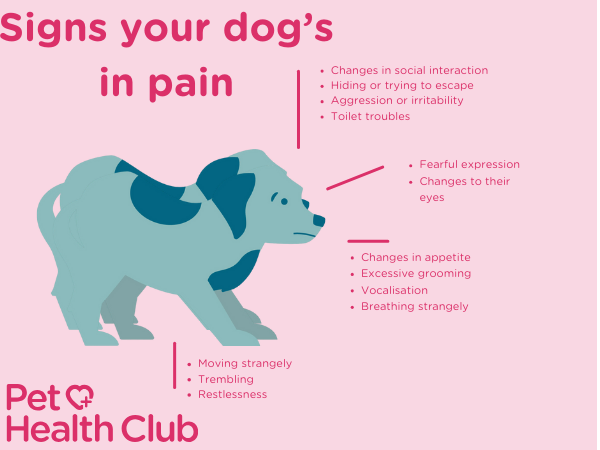How do I know if my dog is in pain?
Accidents happen, and it’s highly likely that your dog will find themselves in pain at some point during their life. It could come from an illness or injury, joint pains, or even a fight with another dog. The question is how do you know your dog’s in pain?
Dogs can’t tell us when they're hurt, but luckily they'll show signs and it’s up to us to understand what they’re telling us.
That’s why we've put together this comprehensive list of signs your dog may be in pain and what you can do to help them.
Moving strangely
If your dog starts moving strangely, limping, walking oddly, or showing a lack of mobility, they could be in pain. Some dogs may tremble or pant excessively, paw at their eyes, or rub sore ears on the ground. Restlessness or reluctance to lie down can also indicate pain. If your dog is usually very active and suddenly stops wanting to leave the house or play, contact your vet.
Changes in appetite
A change to your dog's eating habits, such as refusing food, showing little interest in treats, or a sudden increase in appetite, can signal illness. Your dog might also be suffering from dental issues, especially painful teeth or gums. Watch to see if they’re chewing unusually, drooling or dropping food from their mouth.
Excessive grooming
Excessive grooming could mean your dog has a skin condition, injury or underlying pain. Older dogs sometimes lick skin where they have arthritic pain. Other causes include infected or blocked anal glands or a worm infestation. Regular grooming can help to identify the painful area.
Toilet troubles
If your normally perfectly house-trained dog starts having accidents in the house, or conversely is struggling to pass urine or faeces, it could indicate gastrointestinal, urinary or mobility troubles.
Vocalisation
Pay attention to excessive barking, whining, whimpering or other unusual noises your dog doesn't usually make as it could indicate your dog is in pain. If you touch a painful area, then you can expect some noise as well.
Aggression
Uncharacteristic aggression can be a sign of pain. If your dog starts showing signs of aggression, try to keep a note of when this happens and what was going on at the time. This can help your vet build a clearer picture of what may be triggering it, including potential causes of pain.
Changes in social interaction
Dogs in pain often prefer to be alone, sleep more, and seek quieter spots in the house. However, they can also become clingier, needing more attention than usual. This can also happen when your female dog is going through their season.
Altered breathing
Heavy panting or rapid breathing can be a sign of pain or respiratory trouble. Panting heavily when they aren't exercising or hot, or rapid shallow breathing is concerning, and you should visit your vet immediately.
Changes to the eyes
Blinking and squinting can be signs of eye injuries or diseases in dogs. If your dog is blinking more than usual or squinting, it could be a sign of eye pain. They may also paw at the eye, and rub it on the ground or furniture. Pay attention to how they respond to bright light and contact your vet if you notice any of these signs.
Restlessness
Restlessness or changes in your dog’s sleeping habits may indicate pain in dogs. If your dog is pacing back and forth repeatedly, has difficulty getting comfortable or is sleeping a lot less, there could be an underlying issue.
Trembling
Trembling is a common symptom of pain in dogs. If your dog is trembling and it's not cold, this could be a sign of pain. Make note of when this happens, such as after exercise, after rest or after eating.

What to do when your dog's in pain
Watch your dog
Being alert and aware of any changes in your dog's behaviour and habits is so important. Pay special attention to fluctuating appetite, unusual movements, over-grooming, or vocalisations that are out of the ordinary. The more information you can give the vet, the better.
Think about what they’ve been doing
Think back to what you and your dog have been up to recently that could have caused an injury or soreness. Have you been walking longer and further than usual? Has your dog been on a play-date with other dogs? Understanding the situations that could have led to the injury will help prevent them in future.
Watch how they move
Are they walking in a limp, walking slower or not wanting to leave the house? Do they seem hesitant to walk up and down stairs or struggle to do things they can normally do easily? These can be warning signs of discomfort, especially in joints or limbs.
Keep a journal
Keep track of any changes in your dog's symptoms, behaviour and activities. This will be useful in helping to pinpoint any patterns or causes and will help your vet make a speedy diagnosis.
Speak to your vet
Contact your vet if your dog is showing any signs of pain. Describe the symptoms and behaviours you have observed. Your veterinarian can provide advice on what steps to take next, which might include an appointment at the clinic.
Visit your vet
At the vet appointment, your dog will be given a comprehensive checkup. The vet may also carry out tests to figure out the cause of the pain. These may include blood tests, urine samples or imaging such as x-rays.
Follow the treatment plan
Follow what your vet says, whether it involves medications, physical therapy, or making alterations to diet and exercise. It’s essential to take any medication for the whole course, even if getting your dog to take tablets is difficult - speak to your vet if you’re finding it hard to medicate your pet.
Comfort them
Do all you can to keep your dog relaxed and comforted. Make sure they have a comfy place to sleep, keep them warm, and shower them with love. Make sure they can perform basic functions, such as helping them eat or toilet.
Monitor them
Keep track of your dog's progress during the treatment. If the symptoms persist or worsen, contact your vet immediately.

Pain management for dogs
Common pain medications for dogs include:
Nonsteroidal Anti-Inflammatory Drugs (NSAIDs)
These medications are frequently used to alleviate mild to moderate pain in dogs. There are many types, including carprofen, deracoxib, firocoxib, meloxicam, and grapiprant. They are very effective and widely used. As with all medications, there are some known side effects such as an upset tummy and kidney impairment. Your vet will be able to discuss with you whether these drugs are suitable for your dog.
Opioid analgesics
Opioids may be prescribed as a stronger form of pain relief for more intense cases, like post-surgical pain or cancer. These medications can include buprenorphine, methadone and morphine. These drugs are highly regulated and your vet will only prescribe them in small amounts. .
Other medications
Other medications, such as gabapentin and tramadol, are rarely used alone but can be used as additions to provide extra relief. Gabapentin is an anticonvulsant which can reduce nerve pain and chronic pain, while tramadol is a synthetic opioid-like analgesic which is sometimes used to manage mild to moderate pain.
Natural Remedies and supplements
Using natural treatments and supplements, for example joint supplements containing glucosamine and chondroitin, do not treat pain and should not be used as an alternative to pain-killers. However, they may play a role in managing disease progression. It's best to consult a veterinarian before taking this approach.
Pain management alternatives
Using other treatments for pain relief in dogs is becoming more and more popular, such as acupuncture, hydrotherapy, and physical therapy. These can be used alongside traditional pain medications.
Can I give my dog human medicine
It's understandable to want to relieve your pet's pain. However, administering human medication to your dog could bring about severe repercussions for numerous reasons.
Different metabolic processes
The manner in which a dog's body breaks down substances is different from that of a human's, so a medication that is harmless to you may not be harmless to your canine companion. Even an ordinary non-prescription drug can be damaging or fatal to your dog.
Dosage differences
The amount of medication prescribed for dogs can often be very different from that given to humans. Even if the drug is not dangerous for dogs, administering incorrect dosages can have dire consequences. Overdosing can cause severe health problems such as kidney or liver damage, seizures, and even death.
Potential for poisoning
Dogs should not be given human medications, as numerous popular medicines can be toxic to them. Acetaminophen, which is found in Tylenol, can lead to liver damage in dogs, whereas some nonsteroidal anti-inflammatory drugs (NSAIDs) such as ibuprofen may cause stomach ulceration and kidney failure.
Adverse reactions
Human medications can adversely affect dogs, from minor issues like skin allergies or stomach issues to serious complications like breathing difficulties and anaphylaxis.
Interactions with other medications
It is essential to be aware that if your dog is taking medication, providing them with human medication could result in their regular medication being less effective, increased likelihood of side effects, or potentially new health issues. Only give your dog vet-prescribed medications.
It can be heartbreaking to witness your dog in pain, but medicines made for humans can be dangerous to them. Always seek advice from your vet before giving your dog any kind of medication. A vet can provide the correct medication designed for dogs and provide you with the correct dosage instructions.
Why do dogs hide their pain?
In the wild, dogs have developed the ability to hide their distress as a means of self-preservation. In the wild, showing any signs of weakness could draw predators to them. This same natural impulse is seen in dogs living with us today, which is why a dog in discomfort will often hide their distress.

Need more info?
For more help and guidance on pain in dogs, and the conditions which may cause serious pain, have a chat with your local vet.
Find your nearest vet using our Find a Vet page, or speak to a vet online using Online Vets.


